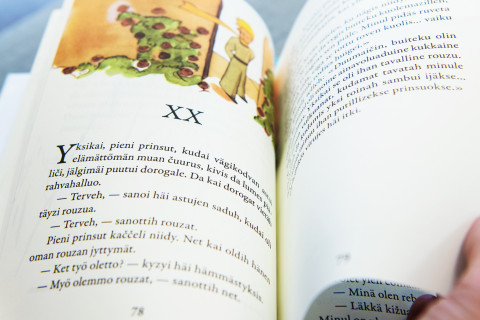Some estimates say that one language disappears from the face of the earth every two weeks. Making sure that the Karelian language doesn’t become one of them is on the agenda at the University of Eastern Finland.
“Finland has two official languages, Finnish and Swedish. As speakers of these languages, we also have the obligation to look after the country’s minority languages. I like to use the term ‘majority responsibility’,” Professor Helka Riionheimo explains, shedding light on why she has devoted years of work to the endangered Karelian language and its revitalisation.
Karelian is a language spoken by some 36,000 people, approximately 11,000 of them on the Finnish side of the Finnish-Russian border, and 25,000 on the Russian side. It is also estimated that roughly another 20,000 people in Finland understand Karelian.
“The Karelian language is spoken on both sides of the Finnish-Russian border. This creates its own challenges and special features for language revitalisation, and also constitutes fertile ground for linguistic research.”
A great setback for the Karelian language was experienced after the Second World War, when Border Karelia – then part of Finland – was ceded to the Soviet Union.
“People living in the area were resettled in other parts of Finland. At the time, the Karelian language was regarded as odd, and children who spoke it were bullied at school due to their strange way of talking. Some schools even went as far as banning the use of Karelian altogether.”
In this climate, many felt that it was easier to learn the Finnish language and to blend in.
“However, preventing people from speaking their mother tongue can cause emotional problems and be traumatising, especially if the language shift is associated with other difficult experiences. This, unfortunately, was true in many cases.”
The disappearance of a language is also sad from a broader perspective.
“When a language is lost, so is everything we know about its lexicon and grammar. We lose valuable insight into everything a human language is capable of.”
Furthermore, oral tradition is passed down from one generation to another in the mother language. When words are lost, so is the valuable oral tradition of indigenous peoples relating to nature, for example.
“Language is more than an instrument of interaction. It carries plenty of knowledge and layers of history with it,” Riionheimo concludes.
Luckily, there is a new-found interest in the Karelian language and culture among the younger generation, and the “burden of shame” once associated with the language is no longer there. This is something Early Stage Researcher Susanna Tavi has also noticed. She is currently writing her doctoral dissertation on the development of the Karelian lexicon.
“It’s actually a little surprising that this hasn’t been studied before from both points of view, Karelian in Finland and in Russia. The fact that the majority of the speakers of Karelian are or have been bilingual is also interesting. In addition to Karelian, they also speak either Finnish or Russian, and this is reflected in their use of vocabulary.”
The University of Eastern Finland offers education in the Karelian language as a full academic subject, while other universities in Finland merely offer individual courses. Future teachers of the Finnish language also learn the basics of Karelian at UEF.
“It is important that Finnish teachers spread knowledge about the Karelian language in their schools. That’s awareness raising in its natural form,” Riionheimo says.
Students are keen to learn Karelian. According to Tavi, some students have roots in the old Karelia, making them fascinated by the language. Others just find the language exotic.
“And some students could even be described as language activists: that’s how strong a stand they have taken for this minority language.”
Natalia Giloeva, a project researcher and a translator, professes to be a language activist. She is also a radio newsreader and translator of Karelian-language news.
“I used to teach the Karelian language at Petrozavodsk State University before I started to teach here in Joensuu. Being a news editor, my work became more and more about translation, and now I see myself as an active language developer,” Giloeva says.
As a language spoken mainly in the spheres of home and family rather than in official contexts, some aspects of Karelian remain inadequate. Moreover, because many speakers of Karelian are old, the language is somewhat old-fashioned. When translating news, Giloeva is constantly faced with having to coin new words.
“This is why translating is a slow process. I have a big responsibility, because the vocabulary I translate and create is immediately visible to everyone, and can be copied from the internet.”
Great care is required with new words, because sometimes people copy them with misspellings and all.
“Coining new words is a collaborative process. Speakers of Karelian are active on social media, and I often ask their opinions on new words there. Social media is a very quick channel to get suggestions and feedback.”
Although the revitalisation of the Karelian language is in good hands, there is still plenty that needs to be done.
“Good and encouraging examples of language revitalisation can be found in the Sami languages here in Finland, and in the Basque language spoken in the border area between Spain and France,” Riionheimo points out.
Throughout the world, minority languages have plenty in common. The revitalisation of the Karelian language is not a mission impossible, the researchers concur.
“However, it does require a lot of effort from individuals, but there are positive signs. Education, research and language revitalisation continue actively, especially here in eastern Finland.”
